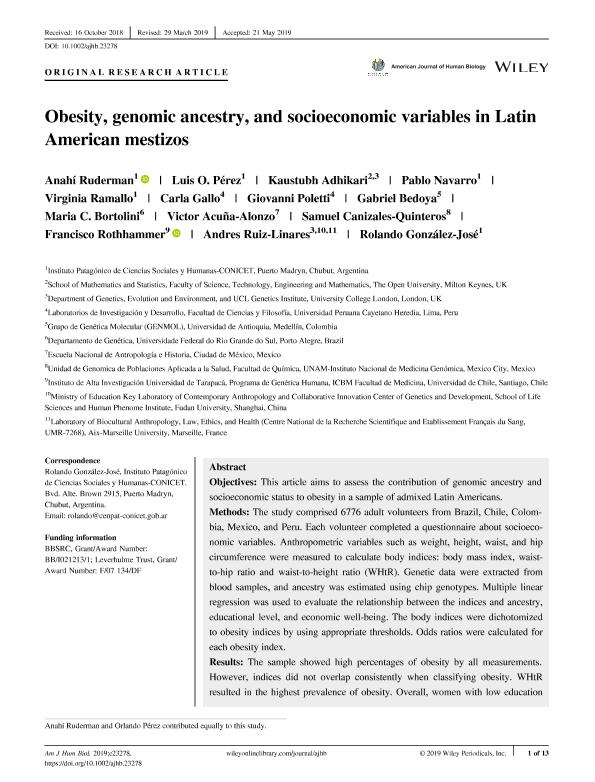Mostrar el registro sencillo del ítem
dc.contributor.author
Ruderman, Anahí

dc.contributor.author
Perez, Luis Orlando

dc.contributor.author
Adhikari, Kaustubh
dc.contributor.author
Navarro, Pablo
dc.contributor.author
Ramallo, Virginia

dc.contributor.author
Gallo, Carla
dc.contributor.author
Poletti, Giovanni
dc.contributor.author
Bedoya Berrío, Gabriel

dc.contributor.author
Bortolini, María Cátira

dc.contributor.author
Acuña Alonzo, Victor
dc.contributor.author
Canizales Quinteros, Samuel
dc.contributor.author
Rothhammer, Francisco
dc.contributor.author
Ruiz-Linares, Andres

dc.contributor.author
González José, Rolando

dc.date.available
2020-03-13T14:07:16Z
dc.date.issued
2019-09
dc.identifier.citation
Ruderman, Anahí; Perez, Luis Orlando; Adhikari, Kaustubh; Navarro, Pablo; Ramallo, Virginia; et al.; Obesity, genomic ancestry, and socioeconomic variables in Latin American mestizos; Wiley-liss, Div John Wiley & Sons Inc; American Journal of Human Biology; 31; 5; 9-2019; 1-13
dc.identifier.issn
1042-0533
dc.identifier.uri
http://hdl.handle.net/11336/99444
dc.description.abstract
Objectives: This article aims to assess the contribution of genomic ancestry and socioeconomic status to obesity in a sample of admixed Latin Americans. Methods: The study comprised 6776 adult volunteers from Brazil, Chile, Colombia, Mexico, and Peru. Each volunteer completed a questionnaire about socioeconomic variables. Anthropometric variables such as weight, height, waist, and hip circumference were measured to calculate body indices: body mass index, waist-to-hip ratio and waist-to-height ratio (WHtR). Genetic data were extracted from blood samples, and ancestry was estimated using chip genotypes. Multiple linear regression was used to evaluate the relationship between the indices and ancestry, educational level, and economic well-being. The body indices were dichotomized to obesity indices by using appropriate thresholds. Odds ratios were calculated for each obesity index. Results: The sample showed high percentages of obesity by all measurements. However, indices did not overlap consistently when classifying obesity. WHtR resulted in the highest prevalence of obesity. Overall, women with low education level and men with high economic wellness were more likely to be obese. American ancestry was statistically associated with obesity indices, although to a lesser extent than socioeconomic variables. Conclusions: The proportion of obesity was heavily dependent on the index and the population. Genomic ancestry has a significant influence on the anthropometric measurements, especially on central adiposity. As a whole, we detected a large interpopulation variation that suggests that better approaches to overweight and obesity phenotypes are needed in order to obtain more precise reference values.
dc.format
application/pdf
dc.language.iso
eng
dc.publisher
Wiley-liss, Div John Wiley & Sons Inc

dc.rights
info:eu-repo/semantics/openAccess
dc.rights.uri
https://creativecommons.org/licenses/by-nc-sa/2.5/ar/
dc.subject
Genomic ancestry
dc.subject
Admixed populations
dc.subject
Obesity
dc.subject.classification
Otras Ciencias Biológicas

dc.subject.classification
Ciencias Biológicas

dc.subject.classification
CIENCIAS NATURALES Y EXACTAS

dc.title
Obesity, genomic ancestry, and socioeconomic variables in Latin American mestizos
dc.type
info:eu-repo/semantics/article
dc.type
info:ar-repo/semantics/artículo
dc.type
info:eu-repo/semantics/publishedVersion
dc.date.updated
2019-12-11T18:48:27Z
dc.journal.volume
31
dc.journal.number
5
dc.journal.pagination
1-13
dc.journal.pais
Estados Unidos

dc.description.fil
Fil: Ruderman, Anahí. Consejo Nacional de Investigaciones Científicas y Técnicas. Centro Científico Tecnológico Conicet - Centro Nacional Patagónico. Instituto Patagónico de Ciencias Sociales y Humanas; Argentina
dc.description.fil
Fil: Perez, Luis Orlando. Consejo Nacional de Investigaciones Científicas y Técnicas. Centro Científico Tecnológico Conicet - Centro Nacional Patagónico. Instituto Patagónico de Ciencias Sociales y Humanas; Argentina
dc.description.fil
Fil: Adhikari, Kaustubh. Colegio Universitario de Londres; Reino Unido. Open University; Reino Unido
dc.description.fil
Fil: Navarro, Pablo. Consejo Nacional de Investigaciones Científicas y Técnicas. Centro Científico Tecnológico Conicet - Centro Nacional Patagónico. Instituto Patagónico de Ciencias Sociales y Humanas; Argentina
dc.description.fil
Fil: Ramallo, Virginia. Consejo Nacional de Investigaciones Científicas y Técnicas. Centro Científico Tecnológico Conicet - Centro Nacional Patagónico. Instituto Patagónico de Ciencias Sociales y Humanas; Argentina
dc.description.fil
Fil: Gallo, Carla. Universidad Peruana Cayetano Heredia; Perú
dc.description.fil
Fil: Poletti, Giovanni. Universidad Peruana Cayetano Heredia; Perú
dc.description.fil
Fil: Bedoya Berrío, Gabriel. Universidad de Antioquia; Colombia
dc.description.fil
Fil: Bortolini, María Cátira. Universidade Federal do Rio Grande do Sul; Brasil
dc.description.fil
Fil: Acuña Alonzo, Victor. Instituto Nacional de Antropología E Historia; México
dc.description.fil
Fil: Canizales Quinteros, Samuel. Instituto Nacional de Medicina Genómica; México
dc.description.fil
Fil: Rothhammer, Francisco. Universidad de Chile; Chile
dc.description.fil
Fil: Ruiz-Linares, Andres. Colegio Universitario de Londres; Reino Unido. Fudan University; China
dc.description.fil
Fil: González José, Rolando. Consejo Nacional de Investigaciones Científicas y Técnicas. Centro Científico Tecnológico Conicet - Centro Nacional Patagónico. Instituto Patagónico de Ciencias Sociales y Humanas; Argentina
dc.journal.title
American Journal of Human Biology

dc.relation.alternativeid
info:eu-repo/semantics/altIdentifier/doi/http://dx.doi.org/10.1002/ajhb.23278
dc.relation.alternativeid
info:eu-repo/semantics/altIdentifier/url/https://onlinelibrary.wiley.com/doi/full/10.1002/ajhb.23278
Archivos asociados
